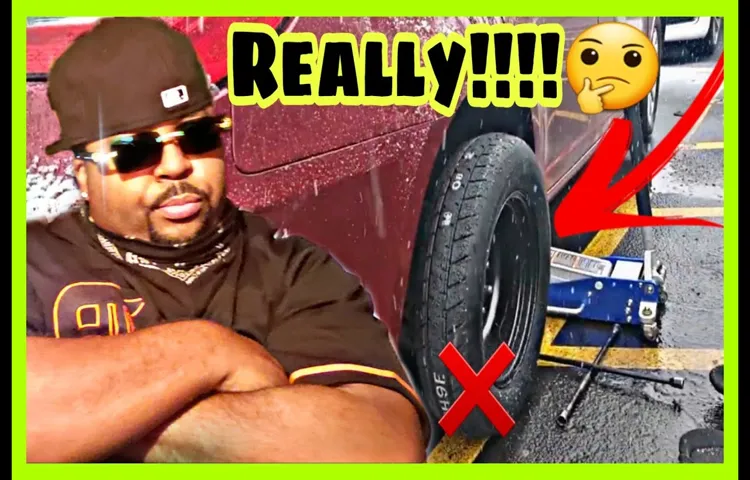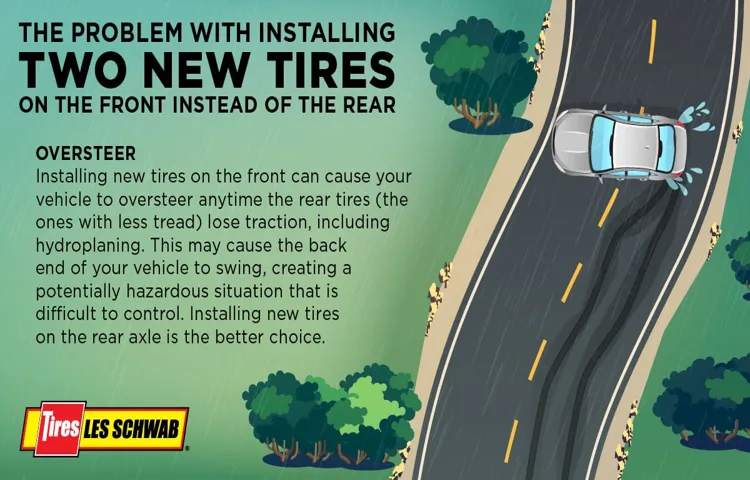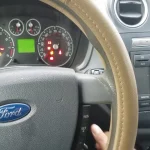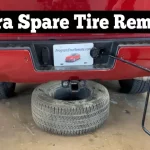Have you ever seen a car driving on the road with a backwards tire? It’s an unsettling sight, and for good reason. Not only does it look strange, but it can also be incredibly dangerous. A backwards tire can cause a variety of issues, ranging from reduced traction and steering control to increased risk of blowouts and accidents.
In this blog post, we’ll explore the risks and consequences of driving with a backwards tire, and why it’s essential to keep your tires properly mounted and aligned for your safety on the road. So buckle up and let’s dive in!
Table of Contents
What Happens When You Put a Tire on Backwards?
Have you ever wondered what happens if a tire is put on backwards? Well, it’s not just an inconvenience or a minor issue that you can overlook. In fact, it can be a safety hazard and lead to disastrous consequences. When a tire is mounted in reverse, the tread patterns that are designed to give you better traction and prevent hydroplaning can’t do their job properly.
This means you’ll have reduced grip and control while driving, especially in wet or slippery conditions. Not to mention, a backwards tire also wears out unevenly because it’s rotating in the opposite direction it was intended to. It can also cause the tire to overheat, which in turn can weaken its structure and lead to a blowout.
So, always make sure that you double-check the direction of your tires before mounting them on your wheels. A simple mistake like this can be avoided by paying attention to the little details, which in turn, will ensure your safety on the road.
Impact on Traction and Handling
Putting a tire on backwards can have a significant impact on both traction and handling. When a tire is put on backwards, the treads are facing the wrong direction, which can reduce the overall grip on the road. This can be especially dangerous in wet or slippery conditions, as the tire will have less contact with the road and be more prone to skidding.
Additionally, putting a tire on backwards can alter the handling of the vehicle. The tire is designed to work in a specific way, and reversing it can cause the vehicle to pull to one side or the other, making it more difficult to steer and control. In short, it’s always best to double check the direction of the treads before mounting a tire.
Even a simple mistake can have serious consequences on the road. So, be careful and ensure that you install your tires correctly to avoid any such risks.

Causes Uneven Wear and Damage
When you put a tire on backwards, it can cause uneven wear and damage. This happens because the tread pattern is designed to provide maximum grip and stability when facing a certain direction. So, when you flip the tire the other way around, the tread is working against the vehicle’s movement, leading to less effective traction and control.
Additionally, installing a tire backwards can also cause stress on the sidewall, leading to bulges and eventual blowouts. It’s crucial to double-check the direction of your tires before mounting them to avoid any unsafe driving conditions. Always remember, a small mistake can lead to big consequences.
So, take your time and inspect your tires properly before installing them, it will save you time, money, and most importantly, keep you and your fellow drivers safe on the road.
Increases Risk of Blowouts and Accidents
Putting a tire on backwards is a risky move that can lead to blowouts and accidents. This happens because tires have a directional tread pattern, and when they are mounted in the wrong direction, they cannot properly expel water from the road. When water cannot be efficiently removed, the tire loses traction, and the risk of hydroplaning increases significantly.
Additionally, a tire mounted backwards can cause uneven wear, which reduces its overall lifespan and can lead to blowouts. Ultimately, it is essential to ensure that your tires are installed correctly to prevent disastrous consequences. Don’t compromise your safety by neglecting to check the direction of your tires before hitting the road.
It only takes a simple mistake to cause a severe accident.
How to Identify If Your Tire is on Backwards?
Putting a tire on backwards might not seem like a big deal, but it can definitely have negative consequences on your vehicle’s performance and safety. So, how do you know if your tire is on backwards? The first thing you should do is take a closer look at the tread pattern. Tread patterns are designed to offer optimal performance in a certain direction, so if you notice that the direction of the V-shaped grooves on your tire’s tread is pointing in the opposite direction of the travel of the vehicle, then your tire is likely installed backwards.
Driving with a backwards tire can result in less traction, poorer handling, and even reduced fuel efficiency. Therefore, it is essential that you ensure your tires are correctly mounted and facing in the right direction for optimal performance. So, if you notice any abnormal wear patterns or symptoms like increased noise, lower grip, or a decrease in overall handling, then you should consider checking to see if your tire is installed backwards.
Check the Directional Arrows or Markings
Identifying if your tire is on backwards can be a challenging task, but it’s critical to ensure maximum safety on the road. One way to check for this is by looking for directional arrows or markings on the tire. If you see arrows or markings on the sidewall, make sure they’re pointing in the right direction.
Such directional arrows indicate the tire’s intended rotation direction, which should match the direction your vehicle moves. If the arrow points the wrong way, your tire is on backward. This mistake can cause uneven tire wear, reduced traction, and compromised handling, leading to hazardous road conditions.
Remember to always check for directional markings or arrows when mounting new tires, rotating them, or replacing a flat tire. By doing so, you’ll ensure smooth rides and optimal safety on the road.
Inspect the Tread Pattern
When it comes to car maintenance, the tires are often overlooked. Most of us just go with the flow without checking if our tire is on backwards or not. But do you know that your tire’s direction of rotation actually matters? Driving with a tire installed backward can negatively affect your car’s handling and even compromise your safety.
The good news is it’s easy to identify if your tire is on backwards – just inspect the tread pattern. Identify whether it is symmetrical or directional. A symmetrical pattern has a continuous rib tread that is not directional.
On the other hand, directional patterns have a V-shaped groove that pulls water away from the tire. If the V-shaped groove of the tire is pointing the wrong direction, you might have it installed backwards. So, check your tires and make sure to install them in the correct direction to avoid potential accidents on the road.
What to Do If You Put Your Tire on Backwards?
Putting a tire on backwards can be a common mistake, but one that can have serious consequences. When a tire is facing the wrong direction, it can affect the car’s handling, traction, and overall safety. The tread pattern on a tire is specifically designed to provide the best grip and control on the road.
When it is reversed, the car’s handling characteristics change, and it may not be as responsive. Additionally, it can affect the car’s braking performance, which can be especially dangerous in emergency situations. Ultimately, if you accidentally put your tire on backwards, it is important to immediately remove it and reinstall it correctly.
It is a simple mistake that can have a significant impact on the safety of your vehicle, so it’s always best to take extra care when changing tires.
Have Your Tire Reversed/Crossed
If you accidentally put your tire on backwards, there’s no need to panic. It’s a common mistake, especially if you’re changing your own tires for the first time. The good news is that it’s an easy fix: simply have your tire reversed or crossed to the correct position.
When you put your tire on backwards, it can cause your car to pull to one side and affect the overall handling of the vehicle. It can also wear down the tire unevenly and potentially lead to a blowout. If you notice that your tire is on backwards, don’t hesitate to take it to a mechanic or tire shop.
They can quickly and easily fix the issue by flipping the tire to the correct position. It’s a quick and inexpensive fix that can save you a lot of hassle down the road. To avoid putting your tire on backwards in the first place, pay attention to the direction of the tread when mounting the tire.
Look for arrows or markings on the tire that indicate the correct direction of rotation. And if you’re ever unsure, don’t hesitate to reach out for help. It’s always better to be safe than sorry when it comes to your car and your safety on the road.
Replace the Tire if Wear and Damage are Present
If you put your tire on backwards, it’s important to take action quickly to prevent any potential safety hazards. Over time, backwards tires can become worn and damaged, which can lead to a number of issues while driving. The first thing to do is to inspect the tire for any signs of wear and damage.
If you notice any cracks or tears in the rubber, or if the tread is worn down more on one side than the other, it’s time to replace the tire. Trying to flip the tire around and continue using it is not a safe option. A tire that is put on backwards can affect the handling of your vehicle and can put you at risk of losing control.
It’s best to take your car to a professional to have the tire replaced as soon as possible. Remember, safety should always be your top priority when it comes to your vehicle.
In Conclusion
If a tire is put on backwards, it’s like wearing your shoes on the wrong feet – it might make you look a little silly, but it won’t necessarily cause any harm. However, over time the wear and tear on the tire will be uneven, and could lead to a decrease in performance and safety. So, while it might not be the end of the world if you accidentally put a tire on backwards, it’s always best to check, double check, and make sure your “shoes” are on the correct “feet.
“
FAQs
Can a tire really be put on backwards?
Yes, it is possible to put a tire on backwards.
What are the consequences of putting a tire on backwards?
Putting a tire on backwards can lead to increased wear and tear on the tire, reduced traction, and potential blowouts.
How can you tell if a tire is on backwards?
Look for directional arrows on the tire’s sidewall or check the rotation direction indicated by the tire manufacturer.
What should I do if I realize my tire is on backwards?
Take your vehicle to a tire professional and have the tire rotated correctly.
Can putting a tire on backwards affect my vehicle’s performance?
Yes, putting a tire on backwards can affect your vehicle’s performance by reducing traction and stability, and potentially increasing fuel consumption.
Is it safe to drive with a tire that has been put on backwards?
It is not recommended to drive with a tire that has been put on backwards as it can compromise your safety and the safety of others on the road.
Does putting a tire on backwards affect the tire’s warranty?
Putting a tire on backwards can void the tire’s warranty, as it is considered incorrect installation.



